How to deal with white aphids on grapes?
In total, there are more than 4000 species of aphids in nature, affecting a huge number of plants. The white aphid that lives on grapes is called phylloxera. Despite the microscopic size of the parasite, its harmfulness is enormous. If you do not take action when a pest infestation is detected, the vineyard may die. The fight against insects is carried out with the help of chemicals and folk remedies.
Description of phylloxera, forms of vine lesions
The grape aphid belongs to the Phylloxeridae family. This type of insect is considered a monophage, since it uses only one type of plant for food. Phyloxera is found exclusively on the vine.
Insects are difficult to see with the naked eye. The adult female barely reaches a size of 1 mm, and the males are even smaller. The body color of aphids is light, greenish-yellow or with a brown tint.
The defeat of the vine by phylloxera is divided into two forms:
- root;
- sheet.
With root damage, the aphid settles on the upper roots located in the most loose soil layer. As a result of the vital activity of insects, bulges form on the roots, which later crack. This makes the damaged areas a gateway for bacterial and fungal infections. Affected roots begin to rot, which inevitably causes the death of the entire plant.
Phylloxera can be found in the form of a plaque on the roots, which outwardly resembles yellowish dust. In the event that pests attack the leaves, gall swellings filled with parasite larvae form on the underside of the leaf plates. Later, yellowish growths form in their place. The affected leaves curl over time, dry out and fall off.
Life cycle of a parasite
The full development cycle of the pest lives on American and American-European grape hybrids. In this case, the development of aphids occurs in the following order:
- the larval stage of phylloxera passes, hibernating on the roots;
- with the onset of warmth, the larvae become wingless females and lay eggs;
- re-emerged larvae repeat the cycle, including the laying of eggs;
- at the end of June, part of the larvae transforms into nymphs, climbs to the surface and turns into winged females;
- winged aphid produces eggs of 2 species, from which individuals of both sexes appear;
- insects mate, after which the female lays an egg in the wood, from which a leaf-shaped larva emerges in spring and begins its life on young leaves;
- later, this aphid reproduces on the leaves, and its larvae, being in the galls, turn into females capable of laying eggs without fertilization;
- the newly emerged larvae spread through the foliage, and some of them descend to the roots.
The full development cycle lasts 2 years. During it, insects move from roots to leaves, and then back. Affecting Asian and European varieties, aphids undergo an incomplete development cycle and parasitize only on the roots. During the season, the female is able to reproduce from 5 to 8 new generations.
Consequences of infection
With the leaf form of aphid infestation, crop loss does not occur, but the problem is that larvae ripe on the leaves can sink to the roots and damage them. As a result, the winter hardiness of the vine decreases, the plant lacks nutrients, the shoots do not mature properly, and become smaller.
Root damage to grapes by aphids is incurable. When the roots are infected, the vine slows down its growth, reduces the yield.The plant becomes more and more oppressed and dies as a result. An infected vineyard can completely disappear in 3–8 years.
You can recognize the presence of a pest by exposing the upper roots and carefully examining them. Phyloxera prefers loose soil and more often affects young plants.
Prevention measures
Due to the high harmfulness of grape aphids, the prevention of pest infestation is of particular importance.
In order not to bring the phylloxer to your site, you must follow a number of rules:
- Do not buy seedlings on the Internet and in areas related to the zone of severe infection (today it is the Rostov Region, Dagestan, Krasnodar Territory).
- Choose for planting varieties resistant to grape aphids ("Kubanets", "Memory of Zotkina", "Cabernet AZOS", "Jubilee of the Crane", "Muscat", "Aurora Magaracha", "Nugget", "Chocolate" and others).
- Give preference to planting grafted vines. Old proven grape varieties are used as a rootstock, for example, the Austrian "Kober 5BB", the German "CO4", the French "Ferkal", the Moldovan "Vierul".
Before planting, it is necessary to soak the roots of the seedlings in a solution of insecticides that effectively destroy aphids. The procedure should not be too long, otherwise the root system will be damaged and will be able to recover only after a few months. Soaking for 3-5 minutes is sufficient. A significant role is also assigned to correct agricultural practices.
Methods for dealing with grape aphids
Aphids are carried from plant to plant by birds, animals, streams of water or wind, on a dirty instrument. In addition, insects are able to move independently through soil or air (winged phase of development).
Bushes infected with the root form of the grape aphid must be destroyed. They must be uprooted and burned, and the sites of infection must be treated with dichloroethane, which penetrates into the soil to a great depth during fumigation.
The remaining plants in the vineyard are sprayed with insecticide solutions or folk remedies are used. Leaves infected with galls are cut off and destroyed. A week later, the second collection of leaves with larvae developing in their tissues is carried out.
Insecticide application
It is important to destroy the grape aphid, which is on the leaves, where insects in the winged stage of development brought it, as quickly as possible, not allowing it to descend to the roots.
You can fight phylloxera using the following drugs:
- Marshal. A powerful insecticide based on carbosulfan. To prepare the solution, you should choose a liquid form. The drug acts instantly and provides protection for up to 45 days. Does not inhibit plants. The solution is prepared from 7 ml of the product in 10 liters of water.
- "Confidor". The main active ingredient is neonicotinoid. Not suitable for use after biological preparations. For 10 liters of water, 1 ml of the product is consumed. The solution is used for generous spraying.
- Actellik. A universal insecticide based on pirimiphos-methyl. When aphids enter the body, it causes paralysis. The protective period is 2–3 weeks. The working solution is prepared from 1 ampoule of the drug for 2 liters of water. With a large accumulation of pests, the concentration is doubled.
- "Mitak". An effective insectoacaricide based on amitraz. Has a systemic effect. To prepare the solution, add 25 ml of the product to 10 liters of water.
The treatment must be repeated 2-3 times with an interval of 7-10 days.
Insecticides can also be used to prevent infection:
- Primarily, the bushes need to be processed when young leaves appear in the first decade of May.
- The second spraying is carried out at the end of the same month.
- The third treatment should be carried out in the last decade of June.
To prevent the appearance of aphids on the roots, the base of the bushes is watered several times a season with a solution prepared from 1 g of Confidor granules per 10 liters of water.
Auxiliary folk remedies
To begin with, you can try to wash off the aphids with a strong pressure of water, after which the birds will feast on the pests.The procedure is convenient to carry out using a hose. You will have to repeat this procedure several times.
In addition, vineyard treatment for white aphids can be carried out using various infusions and solutions:
- Infusion of tobacco. To begin with, 1 cup of chopped tobacco leaves is poured into 5 liters of hot water and simmered for 20-30 minutes. Then the broth is allowed to brew for 5-6 hours, filtered and used as directed.
- A solution of tar soap. You will need 100 g of soap shavings per 10 liters of water. It is necessary to mix the composition well until the soap is completely dissolved and then generously spray the grape leaves on both sides. The resulting film will prevent the aphids from making punctures.
- Soda solution with salt. For 10 liters of water add 5 tbsp. spoons of soda and 10 tbsp. l. salt. The liquid is stirred until the components are dissolved and used for processing.
- Infusion of tomato tops. Grind the greens and fill a 3-liter jar with it halfway, then pour boiling water over it. After a day, filter the infused mixture, add 20 g of crushed laundry soap, allow it to dissolve and apply the product. Instead of tops, you can use citrus fruit peels.
The same formulations are used for preventive purposes. Spray them on grape bushes, preferably once every 2 weeks.
Taking into account the fact that the fight against the root form of aphid lesion is difficult, the main attention should be paid to preventive measures and the choice of grape varieties resistant to the parasite. If a large area of the vineyard is affected, it is better to clear the area from it. It will be possible to plant a crop again only after 5-6 years.

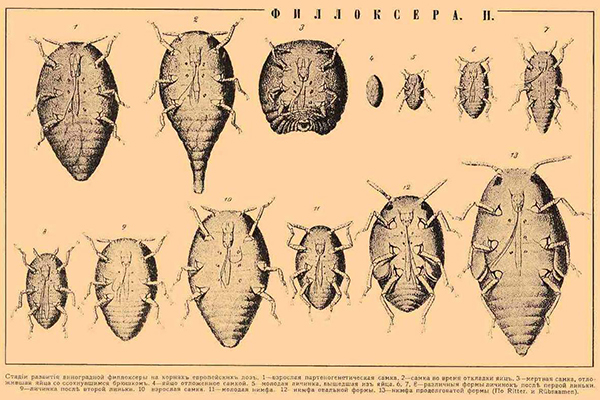
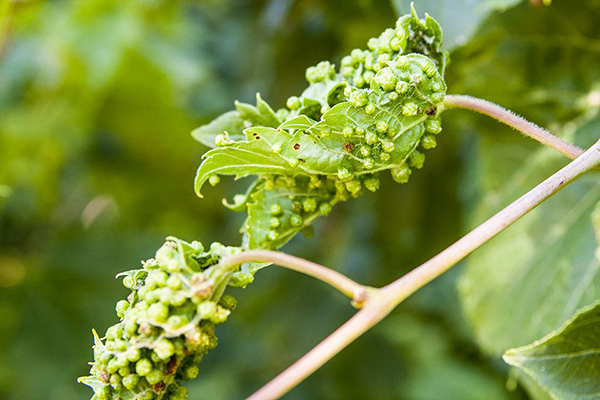


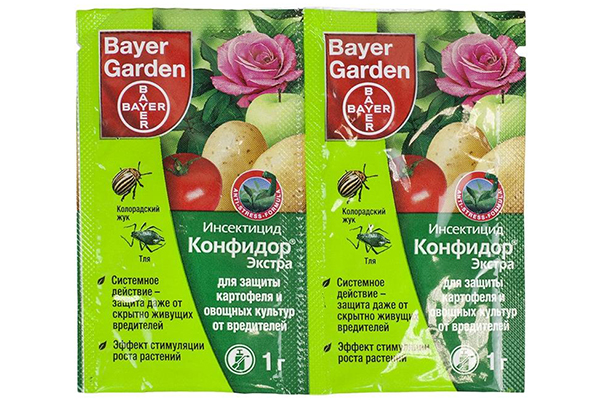

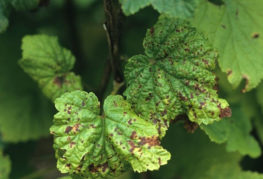
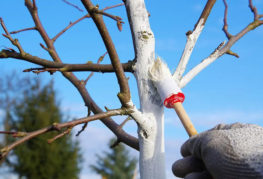
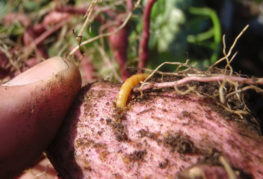
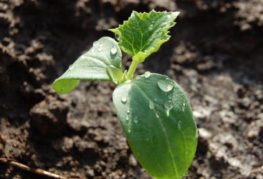

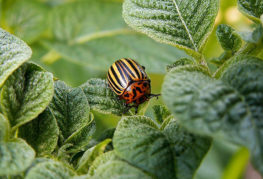
and will be published shortly.